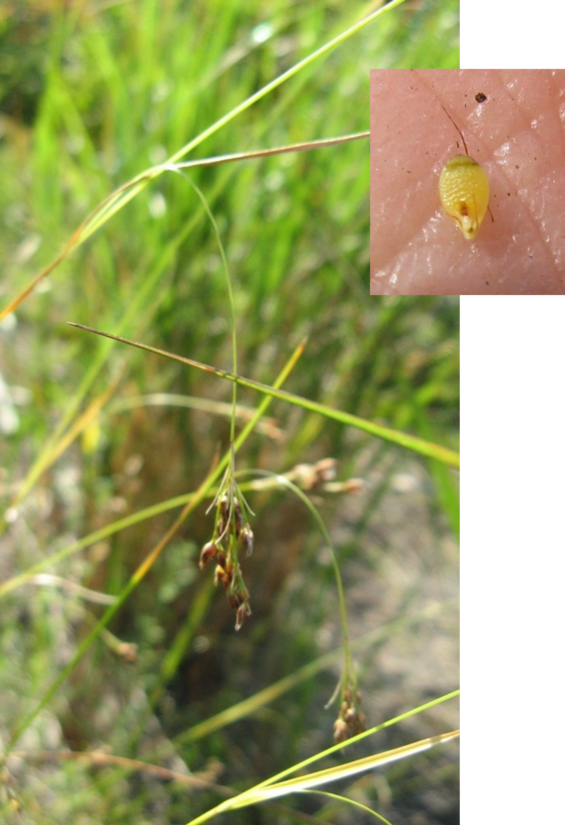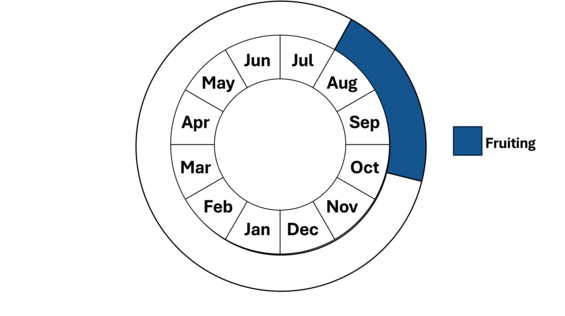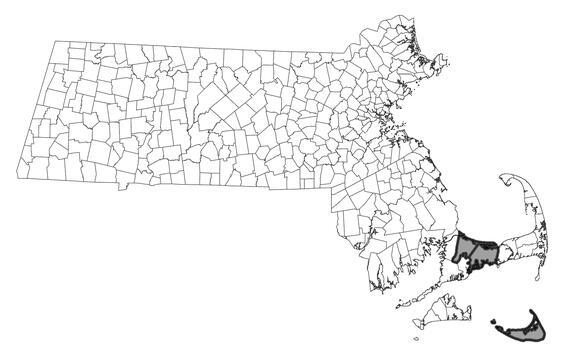- Scientific name: Rhynchospora torreyana
- Species of Greatest Conservation Need (MA State Wildlife Action Plan)
- Endangered (MA Endangered Species Act)
Description

Torrey’s beaksedge growth form.
Torrey’s beaksedge (Rhynchospora torreyana) is a tufted perennial sedge (family Cyperaceae) of coastal damp sands and peats with very slender leaves and a chestnut-colored inflorescence. Torrey’s beaksedge reaches 50-100 cm (19.7-39.4 in), with several stems arising from clumps of very slender 1-2 mm (0.04-0.08 in) basal leaves. The inflorescence is a corymbiform (flat-topped) cluster of two to four branched cymes, made up of chestnut-colored spikelets. The spikelets are egg-shaped, 3-4 mm (0.12-0.16 in) in size, and composed of three to six flowers, each with short, upwardly-serrate (antrorsely barbed) perianth bristles. The dark brown achenes (one-seeded fruits) are tiny, less than 2 mm (<0.08 in), short-beaked, and strongly flattened with about 12 transverse ridges. The wrinkled surface of the achene is visible at 10× magnification. Mature fruit is present from August to early October.
Similar species
Several species of beaksedge inhabit similar habitats as Torrey’s beaksedge, and hence a technical key should be consulted. Brown beaksedge (Rhynchospora capitellata) is a co-occurring species which has denser spikelets and usually downwardly serrate (retrorsely barbed) perianth bristles. Also, the achenes of brown beaksedge are more strongly tapered to the base than those of Torrey’s beaksedge.
Life cycle and behavior
This is a perennial species.

Population status
Torrey’s beaksedge is listed under the Massachusetts Endangered Species Act as Endangered. All listed species are legally protected from killing, collection, possession, or sale, and from activities that would destroy habitat and thus directly or indirectly cause mortality or disrupt critical behaviors.
MassWildlife’s Natural Heritage & Endangered Species Program database has 13 records from 4 counties across the state, not including Hampden, Suffolk, Franklin, and Worcester. Only 3 of those records are within the last 25-year period.
Distribution and abundance
Torrey’s beaksedge occurs along the coastal plain in Massachusetts and Rhode Island, and New Jersey south to Georgia, Alabama, and Mississippi. It is also rare in Delaware, Georgia, Maryland, North Carolina, and Rhode Island, and is presumed to be extirpated from New York.

Distribution in Massachusetts
1999-2024
Based on records in the Natural Heritage Database
Habitat
Torrey’s beaksedge grows along the seasonally wet, sandy to peaty soils of low-nutrient, acidic wetlands, primarily coastal plain pondshores. On Nantucket, Torrey’s beaksedge inhabits areas that simulate seasonally wet pondshores, such as moist mown areas and scraped land near the water table. It prefers full sun and does not compete well with shrubs; therefore, fluctuating water levels are important for the persistence of this species at a site. Associated species include Canada bluejoint (Calamagrostis canadensis), brown beaksedge (Rhynchospora capitellata), yellow-eyed grass (Xyris difformis), and thread-leaf sundew (Drosera filiformis).
Healthy habitats are vital for supporting native wildlife and plants. Explore habitats and learn about conservation and restoration in Massachusetts.
Threats
Torrey’s beaksedge is threatened by any activity that changes the hydrologic regime, water, quality, or soil integrity of the coastal plain pond it inhabits. Region-wide, coastal plain ponds are imperiled due to shoreline development, water table drawdown (from wells), eutrophication (resulting from fertilizers and septic systems), and soil disturbance from heavy recreational use (off-road vehicle, horse, and foot traffic; camping; boat-launching; raking and digging).
Conservation
Management of Torrey’s beaksedge requires protection of the hydrology, water quality, and soil integrity of its habitat. Like many other coastal plain pond shore plant species, Torrey’s beaksedge requires pronounced water-level fluctuations, acidic, nutrient-poor water and substrate, and an open, exposed shoreline, free from major soil disturbance. The hydrologic regime is particularly important; coastal plain pond shore species often require low water years for reproduction, but their persistence at a site depends on high water years to keep dense woody vegetation from taking over the shoreline. Protection of Torrey’s beaksedge habitat may require exclusion of new wells and septic systems, prohibitions on fertilizer use, and restrictions on recreational use of the site. Recreational activities such as swimming, hiking, horseback riding, and off-road vehicle use should be diverted from the plant population location by re-routing trails, installing fences, and providing alternative locations for the activities.
Populations should be monitored to identify threats such as over-shading, invasive plant establishment, and soil disturbance. Torrey’s beaksedge is most likely to be observed in late summer during low water years. Sites that have encroaching woody vegetation can be carefully thinned after the growing season (November–April).
Habitat sites should be checked for the early stages of exotic plant species invasions. The low-nutrient, acidic wetlands inhabited by Torrey’s beaksedge are generally inhospitable for many exotic invasive plants, but invasives could become established at sites that have received heavy soil disturbance or nutrient input. Exotic species that could establish at such sites include common reed (Phragmites australis ssp. australis), gray willow (Salix cinerea), and purple loosestrife (Lythrum salicaria). To avoid inadvertent harm to rare plants, all active management of rare plant populations should be planned in consultation with the MassWildlife’s Natural Heritage & Endangered Species Program.
Contact
| Date published: | May 8, 2025 |
|---|